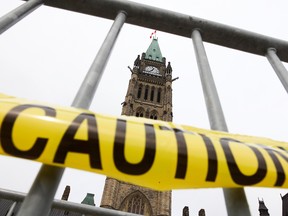Opinion: Our debt problem is a lot worse than Ottawa is letting on
Huge leap in gross debt puts us among top five most indebted

Article content
The Trudeau government continues to defend its debt-financed spending based on international comparisons showing Canada has the lowest debt of any G7 country. But if you broaden the group of comparison countries and use an alternative measure of indebtedness, you get a very different picture of Canada’s debt.
In an IMF ranking of 29 industrialized countries, Canada comes in 19th with a net debt-to-GDP ratio of 33.0 per cent. Eighteen of the 29 countries have higher debt ratios than we do. So that’s a reasonably good showing for us. But move from net debt (which adjusts for financial assets) to gross debt (a measure of total indebtedness), and Canada rises to fifth out of 29. That’s not so good — this is a ranking you don’t want to top. Only Japan, Italy, Portugal and the United States have higher ratios of gross debt to GDP than we do.
And no other country experiences such a dramatic rise in its debt ranking — 14 places — when moving from net debt to gross debt. Finland has the second-largest leap in the rankings but rises only six places, less than half our ascension.

One of the main reasons for this stark contrast between Canada’s net debt and gross debt rankings relates to what’s included in financial assets. The International Monetary Fund’s (IMF) definition includes government-mandated public pensions such as the Canada Pension Plan and the Quebec Pension Plan. This is important because the Canada and Quebec plans are unusual in the industrialized world in that, due to reforms in 1996, they invest in assets other than government bonds, including corporate bonds and stocks. This affects Canada’s measurement of net debt.
Consider a hypothetical case where a government borrows $1 billion to finance spending while its public pension simultaneously buys $1 billion in bonds. The government’s gross debt increases by $1 billion but its net debt doesn’t change because there’s both an asset (the bond held by the pension plan) and a liability. If instead, the public pension invests in non-government bonds and stocks, net debt decreases by $1 billion — and that’s what’s happening in Canada. Our net debt looks better than it actually is because the assets of the Canada and Quebec Pension Plans are included.
But, crucially, earnings from those assets are spoken for — neither our federal nor provincial governments can use earnings from assets held by the pension plans or the assets themselves for anything other than paying for pension benefits. In fact, these assets are critical to meeting pension obligations to current and future retirees.
According to the IMF, the difference between Canada’s net and gross debt is roughly $1.5 trillion, and the assets of the CPP and QPP represent about one-third of that value. The other roughly two-thirds is comprised of financial assets that are fairly standard for most governments, which include currency holdings, cash deposits, debt securities and other receivables.
And yet, Finance Minister Chrystia Freeland continues to use our supposedly low indebtedness to rationalize massive government spending increases based on borrowing, including in her first speech as finance minister and the recent 2021 budget. In reality, Canada’s debt situation is not nearly as rosy as the federal government would have us believe. Ottawa should exercise much more caution in buying things with debt.
Jason Clemens and Milagros Palacios are economists with the Fraser Institute.









Postmedia is committed to maintaining a lively but civil forum for discussion. Please keep comments relevant and respectful. Comments may take up to an hour to appear on the site. You will receive an email if there is a reply to your comment, an update to a thread you follow or if a user you follow comments. Visit our Community Guidelines for more information.